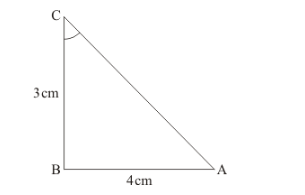If $3 \cot \mathrm{A}=4$, check whether $\frac{1-\tan ^{2} A}{1+\tan ^{2} A}=\cos ^{2} A-\sin ^{2} A$ or not.
Given: $3 \cot A=4$
To check whether $\frac{1-\tan ^{2} A}{1+\tan ^{2} A}=\cos ^{2} A-\sin ^{2} A$ or not
$3 \cot A=4$
Dividing by 3 on both sides,
We get,
$\cot A=\frac{4}{3}$
By definition,
$\cot A=\frac{1}{\tan A}$
Therefore,
$\cot A=\frac{\frac{1}{\text { Perpendicular side opposite to } \angle \mathrm{A}}}{\text { Base side adjacent to } \angle \mathrm{A}}$
$\cot A=\frac{\text { Base side adjacent to } \angle \mathrm{A}}{\text { Perpendicular side opposite to } \angle \mathrm{A}}$$\ldots \ldots(2)$
Comparing Equation (1) and (2)
We get,
Base side adjacent to $\angle A=4$
Perpendicular side opposite to $\angle A=3$
Hence, $\triangle A B C$ is as shown in figure below

In $\triangle A B C$, Hypotenuse is unknown
Hence, It can be found by using Pythagoras theorem
Therefore by applying Pythagoras theorem in $\triangle A B C$
We get
$A C^{2}=A B^{2}+B C^{2}$
Substituting values of sides from the above figure
$A C^{2}=4^{2}+3^{2}$
$A C^{2}=16+9$
$A C^{2}=25$
$A C=\sqrt{25}$
$A C=5$
Hence, Hypotenuse = 5
To check whether $\frac{1-\tan ^{2} A}{1+\tan ^{2} A}=\cos ^{2} A-\sin ^{2} A$ or not
We get the values of $\tan A, \cos A, \sin A$
By definition,
$\tan A=\frac{1}{\cot A}$
Substituting the value ![]() from Equation (1)
from Equation (1)
We get,
$\tan A=\frac{1}{\frac{4}{3}}$
$\tan A=\frac{3}{4}$....(3)
Now by definition,
$\sin A=\frac{\text { Perpendicular side opposite to } \angle A}{\text { Hypotenuse }}$
$\sin A=\frac{B C}{A C}$
Substituting values of sides from the above figure
$\sin A=\frac{3}{5}$.....(4)
Now by definition,
$\cos A=\frac{\text { Base side adjacent to } \angle A}{\text { Hypotenuse }}$
$\cos A=\frac{A B}{A C}$
Substituting values of sides from the above figure
$\cos A=\frac{4}{5} \ldots \ldots$(5)
Now we first take L.H.S of Equation $\frac{1-\tan ^{2} A}{1+\tan ^{2} A}=\cos ^{2} A-\sin ^{2} A$
L.H.S $=\frac{1-\tan ^{2} A}{1+\tan ^{2} A}$
Substituting value of $\tan A$ from equation (3)
We get,
L.H.S $=\frac{1-\left(\frac{3}{4}\right)^{2}}{1+\left(\frac{3}{4}\right)^{2}}$
$\frac{1-\tan ^{2} A}{1+\tan ^{2} A}=\frac{1-\left(\frac{3}{4}\right)^{2}}{1+\left(\frac{3}{4}\right)^{2}}$
$\frac{1-\tan ^{2} A}{1+\tan ^{2} A}=\frac{1-\left(\frac{3^{2}}{4^{2}}\right)}{1+\left(\frac{3^{2}}{4^{2}}\right)}$
$\frac{1-\tan ^{2} A}{1+\tan ^{2} A}=\frac{1-\frac{9}{16}}{1+\frac{9}{16}}$
Taking L.C.M on both numerator and denominator
We get,
$\frac{1-\tan ^{2} A}{1+\tan ^{2} A}=\frac{\frac{16-9}{16}}{\frac{16+9}{16}}$
$\frac{1-\tan ^{2} A}{1+\tan ^{2} A}=\frac{7}{25} \ldots \ldots$(6)
Now we take R.H.S of Equation $\frac{1-\tan ^{2} A}{1+\tan ^{2} A}=\cos ^{2} A-\sin ^{2} A$
R.H.S $=\cos ^{2} A-\sin ^{2} A$
Substituting value of $\sin A$ and $\cos A$ from equation (4) and (5)
We get,
R.H.S $=\left(\frac{4}{5}\right)^{2}-\left(\frac{3}{5}\right)^{2}$
$\cos ^{2} A-\sin ^{2} A=\frac{4^{2}}{5^{2}}-\frac{3^{2}}{5^{2}}$
$\cos ^{2} A-\sin ^{2} A=\frac{16}{25}-\frac{9}{25}$
$\cos ^{2} A-\sin ^{2} A=\frac{16-9}{25}$
$\cos ^{2} A-\sin ^{2} A=\frac{7}{25}$....(7)
Comparing Equation (6) and (7)
We get,
$\frac{1-\tan ^{2} A}{1+\tan ^{2} A}=\cos ^{2} A-\sin ^{2} A$
Answer: Yes $\frac{1-\tan ^{2} A}{1+\tan ^{2} A}=\cos ^{2} A-\sin ^{2} A$
Click here to get exam-ready with eSaral
For making your preparation journey smoother of JEE, NEET and Class 8 to 10, grab our app now.
